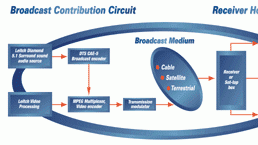New scalable multichannel audio solutions

Figure 1. This typical audio system supported by Leitch and DTS equipment would give a station a simple and compatible transmission audio chain from source to receiver.
The numbers are explosive: DVD player sales are up 39 percent this year and expected to reach 90 percent U.S. household penetration by 2010. Accordingly, consumers’ tastes and expectations are becoming more sophisticated when it comes to both sound and picture quality. In order to compete with high-resolution formats, such as DVD and the emerging D-VHS, broadcasters are increasingly pressured to deliver an experience not currently available through standard broadcast systems. One of the ways that broadcasters can do this is by offering scalable surround sound options with their programming.
One multichannel technology available for home theater installations is from Digital Theater Systems (DTS). In conjunction with the DVB Forum, it is introducing an DVB-compliant encoding system for surround sound that is compatible with terrestrial broadcast, as successfully proven by a test conducted this year by Swedish Radio. In conjunction with Leitch, it has developed an audio system capable of encoding six channels of digital audio into a standard MPEG-2 video stream.
The audio chain
A typical broadcast installation would use a DTS encoder to develop a datastream from up to six channels of pre-processed audio. The encoder provides the processing to sample and scale the audio based on the desired number of inputs and desired quality output.
This data rate can be scaled from 64kb/s up to 1.5Mbps for 5.1- or 6.1-channel. The audio sampling frequency includes 44.1, 48, 88.2 and 96kHz. The system can accomodate multiple configurations including mono, stereo, 5.1- and 6.1-channels. One advantage of these high sampling rates is that they result in a higher-quality decoded signal. While the current AC3 system transmits at 384kb/s, this encoder will allow the broadcaster to choose whatever audio bandwidth is desired. For typical discrete 5.1 transmissions this can range from 384kb/s up to 1.5Mb/s.
The system does more than just multiplex audio channels. During the audio encoding process, the encoder also loads the audio stream with the Packetized Elemental Streams needed for proper decoding. This provides the program supplier with the same control over program audio dynamics as with other systems.
The professional video industry's #1 source for news, trends and product and tech information. Sign up below.
Compatibility
A key broadcast concern with any audio surround system is the need to remain compatible with all consumer receivers and decoders. With the DTS system, viewers need only an STB or receiver with a standard SPDIF output to receive full surround sound audio. (See Figure 1.) DTS is licensed for most companies’ home theater equipment, so it’s common to see the digital output jacks on the back of these units. Some manufacturers are even adding multiple SPDIF outputs so users can switch between a variety of digital audio sources, not just broadcast. For those of us who grew up listening in monaural, getting six channels of audio from our television stations seems like a dream. Fortunately, it has come true.
Ted Laverty is director of business development for DTS Europe.
Editor’s Note: Background information for this article was supplied by DTS. For additional technical information go to their Web site at www.dtsonline.com and click on the “Tech Info” section.
